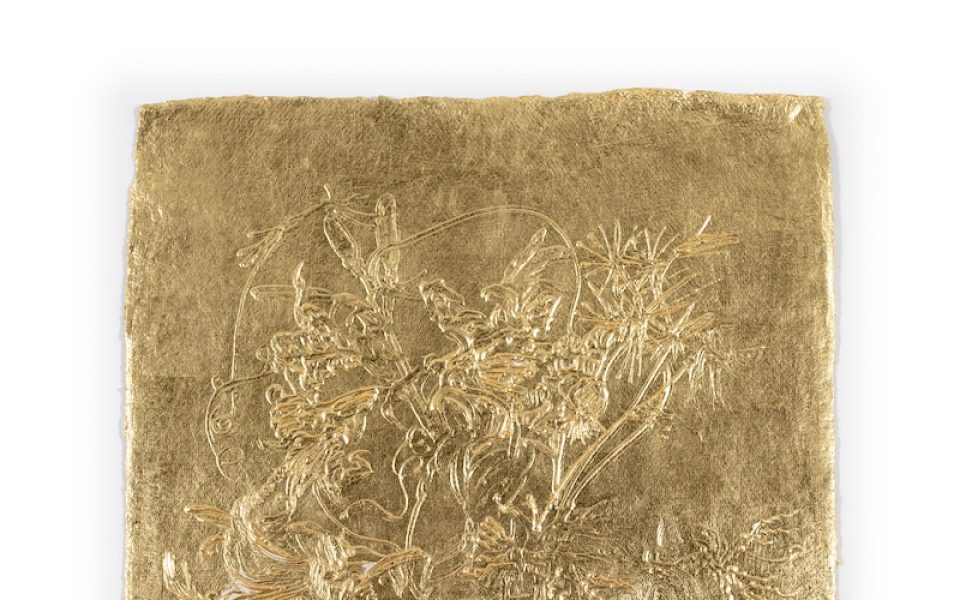A monthly glimpse at the works in the current exhibition Gilded: Contemporary Artists Explore Value and Worth. On view at the Weatherspoon Art Museum at UNCG through April 8, 2023.
Stacy Lynn Waddell, Untitled (Floral Relief 1640), 2022. 22k gold leaf and acrylic medium on paper, 30 × 22 in. Courtesy of the artist and Candice Madey, New York. © Stacy Lynn Waddell, photo by Kunning Huang, courtesy of the artist and Candice Madey, New York
Stacy Lynn Waddell has made gold leaf a mainstay of her artistic practice, turning to the medium time and again in works that explore American history as it relates specifically to her identity as a Black woman living in the South. From seascapes of ships carrying cotton to a portrait of acclaimed author Octavia Butler, Waddell has deployed the precious metal and used its luminous surface to connote honor and worthiness. In 2021, she began a series of works based on 17th Century Dutch flower paintings, works of art that symbolically captured the wealth and abundance of the region’s so-called “Golden Age.”

These still lifes reflected the urbanization of Dutch and Flemish society and an increasing emphasis — among those of means — on commerce, trade, learning and domestic material possessions. Floral paintings were particularly popular and touched on all these areas of interest. Arrangements frequently depicted blooms from multiple geographic locations that would have flowered in different seasons. Impossible to assemble in real life, they were imaginatively combined based on specimens from carefully tended gardens and studiously amassed libraries of botanical books and prints. Those gardens and books, and the vast realm of imported goods of which they were a part, were a direct result of the expanding Dutch trade. The country’s global colonies brought great benefits, but relied on the exploitation of both human and natural resources.
Waddell translates the historical images’ intense variety of colors and array of implied textures into a monochrome field of gold and a singular, physical presence of line. She first covers her paper with acrylic medium, then uses more of this base material to create her images in relief — a process known as pastiglia. Relying on line rather than color, she leaves the blooms looking like dried rather than fresh flowers — a shift that suggests contemporary concerns with ecological fragility in the face of a warming planet. She then gilds the image so that the reflective layer of gold leaf makes the blooms even more difficult to see. These artworks demand viewers’ time, patience, and physical shifts to capture their totality from multiple points of view. When talking about them, she returns frequently to the gold leaf, noting not just its associations with wealth and power, but also its role as a symbol of desire, which is always twofold: desire, if pursued blindly, can lead to actions that hurt others or the world, but desire can also, as Waddell puts it, “create the capacity to change circumstances for the better.”
Gilded: Contemporary Artists Explore Value and Worth is on view at the Weatherspoon Art Museum at UNCG through April 8.
Join the First Amendment Society, a membership that goes directly to funding TCB‘s newsroom.
We believe that reporting can save the world.
The TCB First Amendment Society recognizes the vital role of a free, unfettered press with a bundling of local experiences designed to build community, and unique engagements with our newsroom that will help you understand, and shape, local journalism’s critical role in uplifting the people in our cities.
All revenue goes directly into the newsroom as reporters’ salaries and freelance commissions.


Leave a Reply